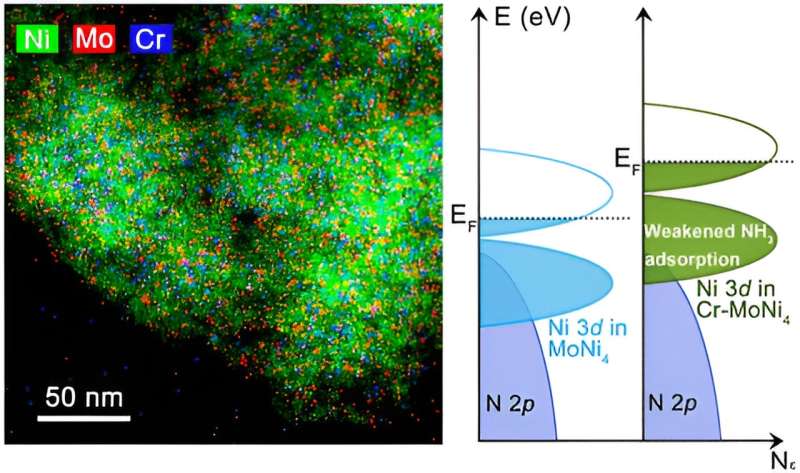This article has been reviewed according to Science X's editorial process and policies. Editors have highlighted the following attributes while ensuring the content's credibility:
fact-checked
peer-reviewed publication
trusted source
proofread
Researchers design ammonia-resistant nickel-based fuel cell catalyst

A research team led by Prof. Gao Minrui from the University of Science and Technology of China (USTC) of the Chinese Academy of Sciences has developed a nickel (Ni)-based anion-exchange membrane fuel cell (AEMFC) anode catalyst with high resistance to ammonia (NH3) toxicity. The work was published in Journal of the American Chemical Society.
Hydrogen fuel cells play an important role in the current energy industry as a nonpolluting power source with high specific energy. However, the commercial platinum on carbon (Pt/C) catalysts are susceptible to ammonia poisoning in hydrogen fuel cells, causing performance degradation. Even worse, the hydrogen oxidation over platinum-based catalysts has slow kinetics in alkaline membrane fuel cells, which synergizes with ammonia poisoning to accelerate the performance degradation. Therefore, a new anode catalyst with high activity and high resistance to ammonia poisoning is urgently needed in the application of AEMFC.
Researchers reasoned that enriching electrons around Ni sites could repel lone-pair electron donation from NH3, and that incorporating metal elements with smaller electronegativity than that of Ni could provide electrons to obtain electron-rich states. By doping chromium (Cr) into the efficient hydrogen oxidation catalyst molybdenum-nickel alloy (MoNi4), the team not only obtained the electron-rich states of Ni to suppress the electron supply of σN-H→dmetal, but also moved the d-band center down to block the reverse electron supply of d→σ*N-H, both of which greatly weakens the ammonia adsorption.
Rotating-disk electrode (RDE) tests showed that the Cr-doped catalyst Cr-MoNi4 underwent 10,000 cycles in the presence of 2 ppm NH3 without significant activity decay, while traditional Pt/C catalyst suffered severe decay under such conditions. In actual alkaline membrane fuel cells assembled with Cr-MoNi4 as anode can maintain 95% of the initial peak power density under 10 ppm NH3, in contrast to 65% of Pt/C catalyst.
It was shown that the Cr modifier created an electron-rich state that effectively inhibits σN-H→d supply, but also downshifted the d-band center, and less d-band filling also limits d-electron supply to the ammonia σ*N-H orbitals, thereby synergistically weakening NH3 binding. In conclusion, Cr-MoNi4 can be used as an efficient, highly NH3-resistant, and cost-effective negative HOR catalyst for AEMFC anode.
The rotating-disk electrode test revealed that Cr-MoNi4 showed no apparent composition and structural changes after 10,000 cycles with 2 ppm of NH3, while the platinum-carbon catalyst had a severe loss of performance. If put in an AEMFC, a device assembled with Cr-MoNi4 can retain 95% of its initial peak power density in the presence of 10 ppm NH3.
Attenuated total reflection surface-enhanced infrared absorption spectroscopy (ATR-SEIRAS) measurements revealed that the Cr-free MoNi4 and the commercial Pt/C catalysts exhibited ammonia adsorption behavior at different potentials, while the Cr-modulated catalysts showed no NH3 adsorption peaks. Electron energy loss spectroscopy (EELS) and electron paramagnetic resonance (EPR) measurements also indicated that the incorporation of Cr increased the occupancy of d-band states.
Prof. Gao's group has been working on the development and application of non-precious metal electrocatalysts for AEMFC. These findings will spur future research on platinum group metal (PGM)-free catalysts that resist poisoning by impurity gases for hydrogen fuel cells.
More information: Ye-Hua Wang et al, Efficient NH3-Tolerant Nickel-Based Hydrogen Oxidation Catalyst for Anion Exchange Membrane Fuel Cells, Journal of the American Chemical Society (2023). DOI: 10.1021/jacs.3c06903
Journal information: Journal of the American Chemical Society
Provided by Chinese Academy of Sciences




















